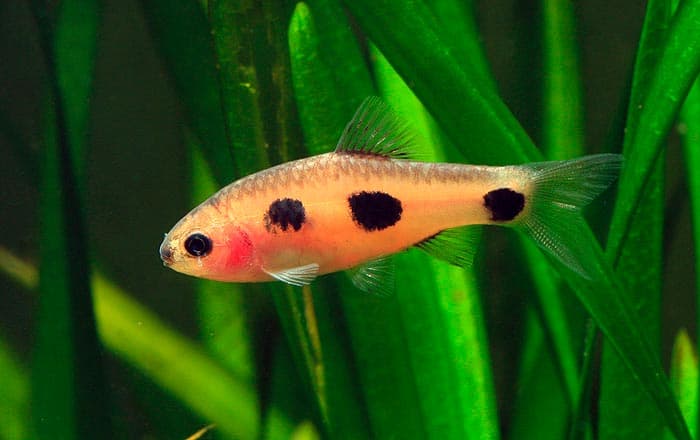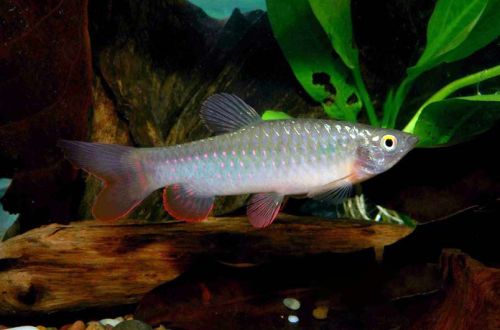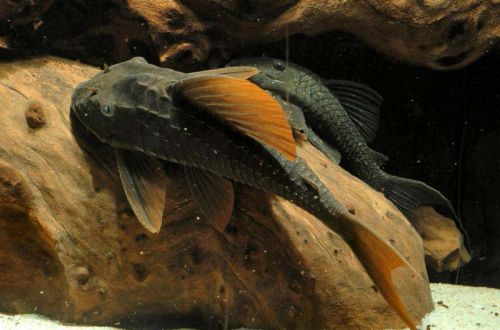
Barbus pinky
The pinkish barb, scientific name Enteromius candens, belongs to the Cyprinidae family. Beautiful peaceful fish with an original body pattern. Easy to keep and breed.

This species is less common in home aquaria, as the supply of wild specimens from the Democratic Republic of the Congo has long been very difficult due to the internal situation in this country.
Contents
Habitat
It comes from the African continent from the territory of the Democratic Republic of the Congo. It is found in the middle basin of the Congo River between the cities of Lisala and Kisangani. It inhabits small unnamed streams and little-known rivers flowing through the rainforest, as well as associated swamps with dense aquatic vegetation.
The water is colored brown, it is given by tannins released as a result of the decomposition of plant matter (fallen leaves and fruits, branches and roots of trees).
Brief information:
- The volume of the aquarium – from 40 liters.
- Temperature – 17-24°C
- Value pH — 5.0–7.0
- Water hardness – 1–5 GH
- Substrate type – any soft
- Lighting is weak
- Brackish water – no
- Water movement is weak
- The size of the fish is about 3 cm.
- Feeding – any food of suitable size
- Temperament – peaceful
- Keeping in a group of 8-10 individuals
Description

Adult individuals reach a length of about 3 cm. Outwardly, it resembles its closest relative, the Butterfly Barb. Sexual dimorphism is weakly expressed, males and females are outwardly very similar to each other and have minor differences. The coloration is pink-yellow with a dark back. Translucent fins have dark edges. A characteristic feature of the body pattern is the presence of three large black spots.
Food
Omnivorous unpretentious fish, they accept most popular foods of a suitable size (dry, freeze-dried, live, frozen). It is recommended to purchase food from well-known and / or trusted manufacturers, since the quality of the products directly affects the health and color of the fish.
Maintenance and care, arrangement of the aquarium
The optimal size of the aquarium for a small flock of these fish starts from 40 liters. The design uses soft dark soil, various snags and thickets of plants. The lighting is subdued. The addition of dry fallen leaves will give the design a natural look, and will also favorably affect the composition of the water, giving it a characteristic “tea” shade. Read more in the article “Which tree leaves can be used in an aquarium.”

Successful keeping of Pinkish Barbs, in addition to quality food, is determined by stable water conditions, which require several standard aquarium maintenance procedures to maintain. These include weekly replacement of part of the water with fresh water, regular cleaning of organic waste (excrement, leftover feed, etc.), equipment maintenance and monitoring of pH, GH, oxidizability.
Behavior and Compatibility
A peaceful, mobile fish, compatible with other miniature species, but the choice of larger aquarium neighbors should be approached with caution. Not even predatory, but rather large fish, for example, from among the catfish, can, on occasion, eat a small pinkish Barb.
It refers to conditionally flocking species, since intraspecific relationships are built on the dominance of the alpha male over relatives. Subdominant individuals prefer to stay at a distance to avoid attacks. However, for a home aquarium, it is desirable to acquire a group of at least 8-10 individuals.
Breeding and reproduction
Under favorable conditions, spawning can occur regularly. Females usually scatter eggs in the water column, and males at this moment fertilize them. Parental instincts are not developed, so there is no care for offspring. Moreover, the “parents” can eat their own caviar and fry. In aquariums with rich vegetation, there is a small chance that fry will be able to grow to adulthood. However, if it is planned to increase the survival of fry, then it will be necessary to prepare a separate tank with identical water conditions, where, for safety, eggs will be placed at the end of spawning.
A separate tank for fry, otherwise called a spawning tank, has a volume of about 10 liters and is equipped with a simple airlift filter with a sponge and a heater. A separate light source is not required.
The incubation period lasts up to 10 days, after another 2-3 days the fry begin to swim freely in search of food. During this initial period, they need microscopic food such as slipper ciliates, as they mature, they will be able to take brine shrimp nauplii or special powdered food.
Fish diseases
In a balanced aquarium ecosystem with species-specific conditions, diseases rarely occur. Diseases are caused by environmental degradation, contact with sick fish, and injuries. If this could not be avoided, then more about the symptoms and methods of treatment in the section “Diseases of aquarium fish”.
Source: FishBase





